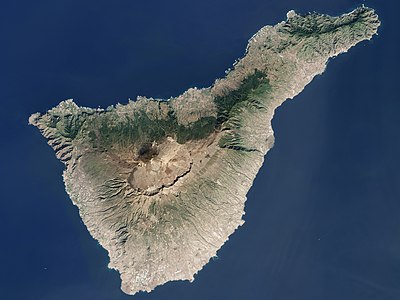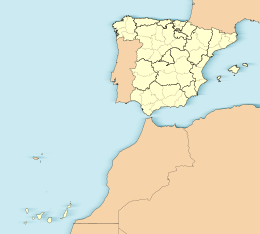
Back Tenerife Afrikaans ቴኔሪፌ Amharic Tenerife AN تينيريف Arabic تينيريفى ARZ Tenerife AST Tenerife Azerbaijani Tenerėfė BAT-SMG Тэнэрыфэ Byelorussian Тэнэрыфэ BE-X-OLD
 Satellite view (April 2023) | |
 Location of Tenerife in the Canary Islands | |
| Geography | |
|---|---|
| Location | Atlantic Ocean |
| Coordinates | 28°16′7″N 16°36′20″W / 28.26861°N 16.60556°W |
| Archipelago | Canary Islands |
| Area | 2,034.38 km2 (785.48 sq mi)[1] |
| Coastline | 342 km (212.5 mi)[1] |
| Highest elevation | 3,715 m (12188 ft)[2] |
| Highest point | Teide |
| Administration | |
Spain | |
| Autonomous Community | Canary Islands |
| Province | Santa Cruz de Tenerife |
| Capital and largest city | Santa Cruz de Tenerife (pop. 208,906) |
| President of the cabildo insular | Rosa Dávila Mamely (2023) |
| Demographics | |
| Demonym | tinerfeño/a; chicharrero/a |
| Population | 948,815 (start of 2023)[3] |
| Pop. density | 466.39/km2 (1207.94/sq mi) |
| Languages | Spanish, specifically Canarian Spanish, formerly Guanche |
| Ethnic groups | Spanish, other minority groups |
| Additional information | |
| Time zone | |
| • Summer (DST) | |
| Official website | www |


Tenerife (/ˌtɛnəˈriːf/ TEN-ə-REEF; Spanish: [teneˈɾife]; formerly spelled Teneriffe) is the largest and most populous island of the Canary Islands.[4] It is home to 42.9% of the total population of the archipelago.[4] With a land area of 2,034.38 square kilometres (785.48 sq mi) and a population of 948,815 inhabitants as of January 2023,[5][6] it is also the most populous island of Spain[4] and of Macaronesia.[7]
Approximately five million tourists visit Tenerife each year; it is the most visited island in the archipelago.[8] It is one of the most important tourist destinations in Spain[9] and the world,[10] hosting one of the world's largest carnivals, the Carnival of Santa Cruz de Tenerife.
The capital of the island, Santa Cruz de Tenerife, is also the seat of the island council (cabildo insular). That city and Las Palmas de Gran Canaria are the co-capitals of the autonomous community of the Canary Islands. The two cities are both home to governmental institutions, such as the offices of the presidency and the ministries. This has been the arrangement since 1927, when the Crown ordered it. (After the 1833 territorial division of Spain, until 1927, Santa Cruz de Tenerife was the sole capital of the Canary Islands).[11][12] Santa Cruz contains the modern Auditorio de Tenerife, the architectural symbol of the Canary Islands.[13][14]
The island is home to the University of La Laguna. Founded in 1792 in San Cristóbal de La Laguna, it is the oldest university in the Canaries. The city of La Laguna is a UNESCO World Heritage Site. It is the second most populous city on the island, and the third most populous in the archipelago. It was the capital of the Canary Islands before Santa Cruz replaced it in 1833.[15] Tenerife is served by two airports; Tenerife North Airport and Tenerife South Airport.
Teide National Park, located in the center of the island, is also a UNESCO World Heritage Site. It includes Mount Teide, which has the highest elevation in Spain, and the highest elevation among all the islands in the Atlantic Ocean. It is also the third-largest volcano in the world, when measured from its base.[16] Another geographical feature of the island, the Macizo de Anaga (massif), has been designated as a UNESCO Biosphere Reserve since 2015.[17] Tenerife also has the largest number of endemic species in Europe.[17]
- ^ a b "Estadística del Territorio" [Territory Statistics] (in Spanish). Instituto Canario de Estadística (ISTAC). Retrieved 17 July 2019.
- ^ "Mapa Físico de España (Physical Map of Spain)". Atlas Nacional de España (National Atlas of Spain). Instituto Geográfico Nacional (Spain). 2012. Retrieved 18 April 2023.
- ^ Instituto Nacional de Estadistica, Madrid, 2023.
- ^ a b c "Instituto Nacional de Estadística. (National Statistics Institute)". Ine.es. Archived from the original on 15 January 2009. Retrieved 19 September 2012.
- ^ Institito Nacional de Estadistica, Madrid, 2023.
- ^ "Real Decreto 1458/2018, de 14 de diciembre, por el que se declaran oficiales las cifras de población resultantes de la revisión del Padrón municipal referidas al 1 de enero de 2019" [Royal Decree 1458/2018, of 14 December, by which the population numbers resulting from the review of the municipal register as of 01 January 2019 are declared official] (PDF) (in Spanish). Ministerio de Economía y Empresa. 2019. Retrieved 18 July 2019.
- ^ "La Macaronesia. Consideraciones geológicas, biogeográficas y paleoecológicas" [Macaronesia: geology, biogeography and palaeo-ecology]. Museos de Tenerife. Archived from the original on 17 November 2015.
- ^ "Canarias recibe 593.604 turistas extranjeros durante el mes de julio, un 16% menos que los registrados en 2008" [The Canaries received 593,604 foreign tourists in the month of July, 16% less than in 2008]. Terra Noticias. 12 August 2009. Archived from the original on 5 June 2012. Retrieved 19 September 2012.
- ^ "Posicionamiento turístico de Tenerife" [Tourism in Tenerife] (PDF). ull.es. Retrieved 18 April 2017.
- ^ "Ranking hecho por viajeros: los mejores destinos del mundo en 2021". lanacion.com. 5 April 2021. Retrieved 17 August 2021.
- ^ Real Decreto de 30 de noviembre de 1833 on Wikisource
- ^ "Real Decreto de 30 de noviembre de 1833" [Royal Decree of 30 November 1833] (PDF). Government of the Canary Isles. Archived from the original (PDF) on 22 July 2012.
- ^ "Auditorio de Tenerife". Treklens. Archived from the original on 10 December 2012. Retrieved 13 October 2009.
- ^ "Correos emite seis sellos con obras emblemáticas de la arquitectura española e incluye el Auditorio de Tenerife". La Region Internacional. Archived from the original on 11 April 2008.
- ^ "San Cristóbal De La Laguna". Diccionario de Arquitectura y Construcción. Arquitectura Uba. Archived from the original on 5 January 2009. Retrieved 19 September 2012.
- ^ "Parque nacional del Teide" [Teide National Park]. Tenerife Tourism Authority. Archived from the original on 26 August 2009.
- ^ a b "El macizo de Anaga alberga mayor concentración de endemismos de toda Europa" [The Macizo de Anago harbours the highest concentration of endemic species in Europe]. Efeverde.com. 9 June 2015. Retrieved 18 April 2017.
© MMXXIII Rich X Search. We shall prevail. All rights reserved. Rich X Search

